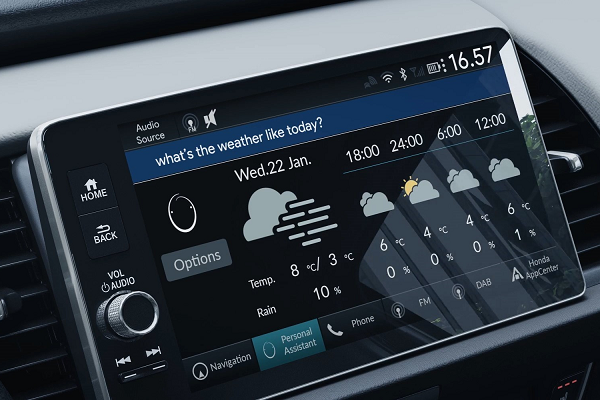First Honda Cars With SoundHound-Powered Voice Assistants Hit the Road
 Honda’s new voice assistant, built on prominent voice AI developer SoundHound’s Houndify platform drove onto the streets for the first time this week. The Honda Personal Assistant is built into the new ‘Honda e’ electric cars, another first for Honda, and some models of the Honda Jazz line of vehicles, awaiting the OK Honda wake word from drivers.
Honda’s new voice assistant, built on prominent voice AI developer SoundHound’s Houndify platform drove onto the streets for the first time this week. The Honda Personal Assistant is built into the new ‘Honda e’ electric cars, another first for Honda, and some models of the Honda Jazz line of vehicles, awaiting the OK Honda wake word from drivers.
Electric Talk
The Honda Personal Assistant relies on Houndify to understand and respond to what people are saying. Drivers can operate the car’s environmental and entertainment controls with voice commands or ask the AI for directions or local information. The voice assistant checks any informational requests against a database of previous questions and commands and checks for geographic context and related details to ensure its answers are as helpful as possible. The Houndify platform enables Honda’s voice assistant to answer multi-part questions, including follow-ups and clarification. For example, Honda suggests asking, “OK Honda, show me recommended restaurants within five kilometers, except French and Italian ones, that have Wi-Fi, and are open past 10 pm.”The voice assistant would be able to answer and would then ask if the driver wants directions.
“We are excited to be part of the historic launch of an electric vehicle by Honda and hope the voice assistant will make Honda e even more appealing,” SoundHound CEO Keyvan Mohajer said in a statement.
 The Honda Personal Assistant has been in the works for two years when the carmaker signed a deal with SoundHound to create the voice assistant. The agreement extended an earlier connection when SoundHound took part in the Honda Xcelerator program. Honda and SoundHound previewed the voice assistant at the Tokyo Motor Show last year and at CES in January, though the final version is more polished and advanced. Honda won’t be talking to drivers everywhere, however. The Honda e is only available in Japan and parts of Europe, while the Jazz models with the voice assistant are limited just to a few European countries.
The Honda Personal Assistant has been in the works for two years when the carmaker signed a deal with SoundHound to create the voice assistant. The agreement extended an earlier connection when SoundHound took part in the Honda Xcelerator program. Honda and SoundHound previewed the voice assistant at the Tokyo Motor Show last year and at CES in January, though the final version is more polished and advanced. Honda won’t be talking to drivers everywhere, however. The Honda e is only available in Japan and parts of Europe, while the Jazz models with the voice assistant are limited just to a few European countries.
Driving AI
SoundHound has been finding a lot of success with the automotive industry. Kia debuted a new car with a Houndify-based voice assistant, and both Hyundai and Mercedes rely on Houndify as an option in some of their models. SoundHound may also be more appealing as a partner for carmakers after reaching an agreement earlier this month with parking services provider Parkopedia to include Parkopedia’s data in Houndify as a third-party service for partners. When a driver in a car with Parkopedia asks about nearby street or garage parking spots, the voice assistant will be able to check against a list of more than 70 million parking spaces in 15,000 cities and 89 countries. For Honda and other automotive partners, another major benefit with SoundHound is that they have more control over their data than with Amazon or Google.
Cars are a significant part of SoundHound’s portfolio, but not the only vertical for the company. Mastercard and SoundHound just started a pilot program to integrate Houndify into payment processing at White Castle and other drive-thrus. This summer, Snapchat added the new Houndify-supported Voice Scan feature that enables people to add a filter with a vocal request. And the company’s work with the hospitality industry and streaming services like Pandora keep SoundHound diversified. But, if 73% of drivers are going to be using an in-car voice assistant by 2022 as some predict, SoundHound won’t be getting off the road any time soon.
Follow @voicebotai Follow @erichschwartz
SoundHound Brings Parking Spot Searching to Houndify Voice Assistants With Parkopedia Partnership
Mastercard and SoundHound’s Voice Assistant Goes to White Castle
Snapchat Taps SoundHound to Add Voice Search for Filters in the App








